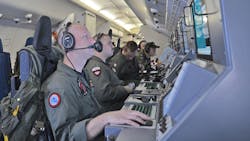Boeing to integrate extra crew workstations in upgrade of Navy P-8A Poseidon maritime surveillance aircraft
PATUXENT RIVER NAS, Md. – U.S. Navy aerial surveillance experts are looking to the Boeing Co. to help expand capabilities of the P-8A Poseidon maritime patrol aircraft with the addition of a crew workstation on early models of the aircraft.
Officials of the Naval Air Systems Command at Patuxent River Naval Air Station, Md., announced two orders last week collectively worth $34.5 million to the Boeing Defense, Space & Security segment in Seattle to provide 60 Sixth Mission Crew Workstation (MCW) retrofit B-kits for the U.S. and Australian navies.
This order will add an extra crew workstation to the first five lots of Navy P-8A aircraft, as well as to the sixth lot of Australian P-8As. Boeing is the original manufacturer of the P-8A.
Early versions of the P-8A Poseidon had five crew workstations, and later versions have six workstations. This order is to upgrade early models of the aircraft to include a sixth crew workstation to enhance the plane's capabilities and distribute the workload more evenly among crew members.
The P-8A has workstations with universal multifunction displays, and ready accommodation for additional workstations and workload sharing.
Of these crew workstations, 51 will go aboard Navy production P-8A aircraft; three will go aboard Navy flight test aircraft, and four will go aboard Royal Australian Air Force aircraft.
The P-8 is a militarized version of the Boeing 737NG single-aisle jetliner hardened for long-range surveillance, maritime patrol, and anti-submarine warfare missions.
The Navy is under contract with Boeing for 111 Poseidon aircraft, and Navy officials say they have a need for additional aircraft. Boeing builds the Poseidon at its factory in Renton, Wash. The 737NG fuselage and tail sections are from Spirit AeroSystems in Wichita, Kan.
The P-8A’s flight management system and the stores management system have been developed by GE Aviation Systems in Grand Rapids, Mich. The cabin has as many as seven operator consoles.
The Poseidon’s MX-20HD digital electro-optical and infrared (EO/IR) multi-spectral sensor turrets come from L-3 Communications Wescam in Burlington, Ontario. The MX-20HD is gyro-stabilized and can have as many as seven sensors, including infrared, CCDTV, image intensifier, laser rangefinder, and laser illuminator.
The aircraft has the upgraded APS-137D(V)5 maritime surveillance radar and signals intelligence (SIGINT) system from the Raytheon Co. Space and Airborne Systems (SAS) segment in McKinney, Texas.
The Raytheon APS-137D(V)5 radar, which is installed on the P-8’s enlarged nose fairing, provides synthetic aperture radar (SAR) for imaging stationary ships and small vessels, coastal and overland surveillance, and high-resolution imaging synthetic aperture radar (ISAR) for imaging surfaced submarines and fast surface vessels operating in coastal waters.
The P-8A has the CAE Inc. advanced integrated magnetic anomaly detection (MAD) system, and eventually may use air-deployable unmanned aerial vehicles (UAVs) to handle magnetic anomaly detection. The Navy plans to arm the P-8A with the MK 54 torpedo.
On this order, Boeing will build and integrate the P-8A crew workstations in Seattle; Huntington Beach, Calif.; and San Antonio, Texas, and should be finished in January 2023.
For more information contact Boeing Defense, Space & Security online at www.boeing.com, or Naval air Systems Command at www.navair.navy.mil.

John Keller | Editor-in-Chief
John Keller is the Editor-in-Chief, Military & Aerospace Electronics Magazine--provides extensive coverage and analysis of enabling electronics and optoelectronic technologies in military, space and commercial aviation applications. John has been a member of the Military & Aerospace Electronics staff since 1989 and chief editor since 1995.

